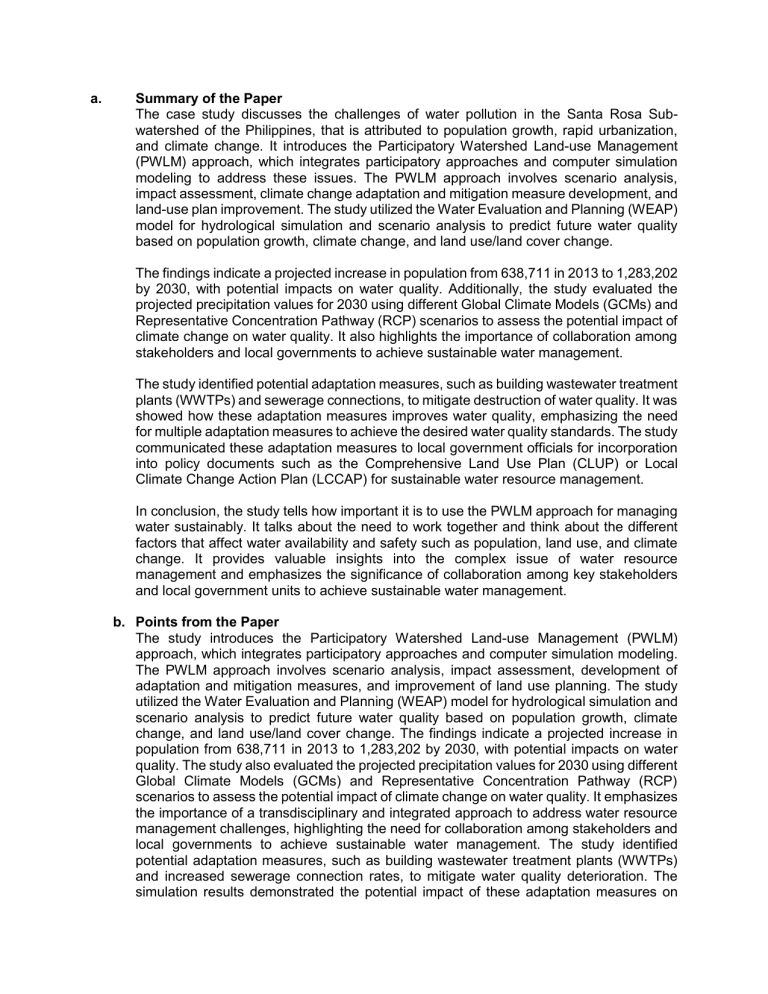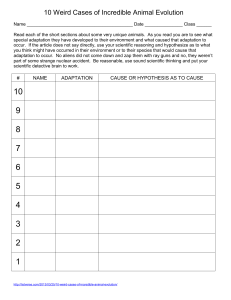
a. Summary of the Paper The case study discusses the challenges of water pollution in the Santa Rosa Subwatershed of the Philippines, that is attributed to population growth, rapid urbanization, and climate change. It introduces the Participatory Watershed Land-use Management (PWLM) approach, which integrates participatory approaches and computer simulation modeling to address these issues. The PWLM approach involves scenario analysis, impact assessment, climate change adaptation and mitigation measure development, and land-use plan improvement. The study utilized the Water Evaluation and Planning (WEAP) model for hydrological simulation and scenario analysis to predict future water quality based on population growth, climate change, and land use/land cover change. The findings indicate a projected increase in population from 638,711 in 2013 to 1,283,202 by 2030, with potential impacts on water quality. Additionally, the study evaluated the projected precipitation values for 2030 using different Global Climate Models (GCMs) and Representative Concentration Pathway (RCP) scenarios to assess the potential impact of climate change on water quality. It also highlights the importance of collaboration among stakeholders and local governments to achieve sustainable water management. The study identified potential adaptation measures, such as building wastewater treatment plants (WWTPs) and sewerage connections, to mitigate destruction of water quality. It was showed how these adaptation measures improves water quality, emphasizing the need for multiple adaptation measures to achieve the desired water quality standards. The study communicated these adaptation measures to local government officials for incorporation into policy documents such as the Comprehensive Land Use Plan (CLUP) or Local Climate Change Action Plan (LCCAP) for sustainable water resource management. In conclusion, the study tells how important it is to use the PWLM approach for managing water sustainably. It talks about the need to work together and think about the different factors that affect water availability and safety such as population, land use, and climate change. It provides valuable insights into the complex issue of water resource management and emphasizes the significance of collaboration among key stakeholders and local government units to achieve sustainable water management. b. Points from the Paper The study introduces the Participatory Watershed Land-use Management (PWLM) approach, which integrates participatory approaches and computer simulation modeling. The PWLM approach involves scenario analysis, impact assessment, development of adaptation and mitigation measures, and improvement of land use planning. The study utilized the Water Evaluation and Planning (WEAP) model for hydrological simulation and scenario analysis to predict future water quality based on population growth, climate change, and land use/land cover change. The findings indicate a projected increase in population from 638,711 in 2013 to 1,283,202 by 2030, with potential impacts on water quality. The study also evaluated the projected precipitation values for 2030 using different Global Climate Models (GCMs) and Representative Concentration Pathway (RCP) scenarios to assess the potential impact of climate change on water quality. It emphasizes the importance of a transdisciplinary and integrated approach to address water resource management challenges, highlighting the need for collaboration among stakeholders and local governments to achieve sustainable water management. The study identified potential adaptation measures, such as building wastewater treatment plants (WWTPs) and increased sewerage connection rates, to mitigate water quality deterioration. The simulation results demonstrated the potential impact of these adaptation measures on improving water quality, emphasizing the need for multiple adaptation measures to achieve the desired water quality standards. c. Issues that are not Clear The concepts and issues that may require further clarification include the specific details of the adaptation measures proposed, the integration of climate change adaptation and mitigation measures into local policies, and the potential impact of these measures on water quality improvement. Additionally, the document mentions the use of the WEAP model for scenario analysis and the need for transdisciplinary approaches, but further details on the specific methodologies and data used for the hydrological simulation and scenario analysis would enhance the understanding of the study. Furthermore, it discusses the challenges of integrating multiple institutions dealing with land-use and water quality issues within a watershed, highlighting the need for a transdisciplinary and integrated approach. However, a more detailed explanation of the institutional challenges and the proposed strategies for addressing these challenges would provide a clearer understanding of the findings. d. Points for improvements/ Recommendations More sampling locations, along with increased frequency of monitoring and monitoring of additional organic/inorganic water quality parameters, should be a priority for further studies in the region. This can help to enhance the accuracy and comprehensiveness of the water quality assessment. To further improve the effectiveness of the approach, it may be beneficial to enhance stakeholder engagement and collaboration, ensuring that all relevant parties are actively involved in decision-making processes and policy implementation. The adaptation measures with scientific evidence of their impact should be communicated to local government officials for incorporation into policy documents such as the Comprehensive Land Use Plan (CLUP) or Local Climate Change Action Plan (LCCAP) for sustainable water resource management. It is recommended to ensure that the proposed adaptation measures are effectively integrated into policy documents and implemented to address water quality deterioration. Prepared by: Marjorie B. Nabor Bicol University College of Engineering – East Campus Civil Engineering Department AY: 2023-2024 ______________________________________________________________________ ______________________________________________________________________ Case Study Summary Report: “Participatory Approach for More Robust Water Resource Management: Case Study of the Santa Rosa Sub-Watershed of the Philippines” By: Pankaj Kumar, Brian Alan Johnson, Rajarshi Dasgupta, Ram Avtar, Shamik Chakraborty, Masayuki Kawai and Damasa B. Magcale-Macandog Submitted by: MARJORIE B. NABOR BS Civil Engineering 3C Submitted to: ENGR. ANNA BILARO, MSCE


